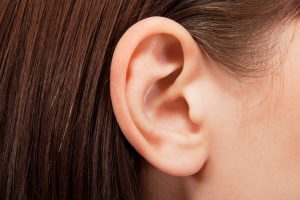A Mass. Eye and Ear specialist explains why earwax is healthy, and why you shouldn’t use q-tips or ear candles to remove it.
The sticky substance found in your ears — known as cerumen or “earwax” — can be a nuisance at times. However, it plays an important role in keeping your ears clean and healthy.
According to recent guidelines issued by the American Academy of Otolaryngology—Head and Neck Surgery (AAO-HNS) outlining healthy ear care, we need to be better about leaving earwax alone. Many of us who use cotton swabs, q-tips and/or other small objects to try to remove it usually end up pushing the wax further into the ear canal.
To better understand earwax, we checked in with Dr. Felipe Santos, an ear surgeon at Mass. Eye and Ear, who shared why it is healthy for our ears.
Earwax Basics
 It is made in the ear canal by modified sweat glands.
It is made in the ear canal by modified sweat glands.- We have more than 1,000 wax glands in our ears.
- Despite its waxy texture, earwax is not actually wax. Rather, it is a mixture of dead skin, fatty acids, cholesterol, squalene and alcohols.
- There are two common types of earwax: wet yellow/brown and dry white/gray. A person’s ethnicity, health and environment can affect how it looks, feels and smells.
What is the purpose of earwax?
- Lubrication: It lubricates the ear canal—without it, our ears would feel dry and itchy.
- Protection: It traps unwanted debris such as dirt and dust to help prevent irritation, inflammation and infection.
- Cleanliness: Earwax is primarily responsible for cleaning our ears. It blocks unwanted matters from entering the ear and then self-cleans. Whenever you move your mouth or jaw, your earwax slowly moves away from your eardrum and eventually flakes off or falls out with the unwanted debris.
When should it be removed?
Since our ears self-clean, most people should not have to worry about cleaning their ears or removing their earwax.
However, if you believe your ears have become blocked from too much wax, cleaning yours ears may be appropriate. Ear blockage symptoms may include ear pain, a feeling of fullness in the ears, ringing in the ears (tinnitus), decreased hearing, dizziness and/or coughing.
For safest removal, see your doctor or an ear, nose and throat specialist. If you can’t get to a doctor, Dr. Santos recommends a few drops of over-the-counter ear drops, hydrogen peroxide, baby oil or mineral oil to soften the wax and encourage it to fall out of the ear on its own.
What about cotton swabs and ear candles?
Neither of these options are safe for cleaning your ears and could damage your ear canal and/or ear drum. According to the AAO-HNS guidelines, nothing smaller than your elbow should be placed in your ear.
For safest earwax removal, see your doctor or an ear, nose and throat specialist.




I have wax built up in both ears and have used Debrox and Hydrogen
Peroxide diluted 50% with warm water. I still can not hear out of each ear.
Hi John, thanks for reading and your comment. We can’t give medical advice over the blog unfortunately, but if you’d like to set up an appointment with an ENT, please call 617-573-3954 or visit our website for more info. https://www.masseyeandear.org/specialties/hearing-and-balance